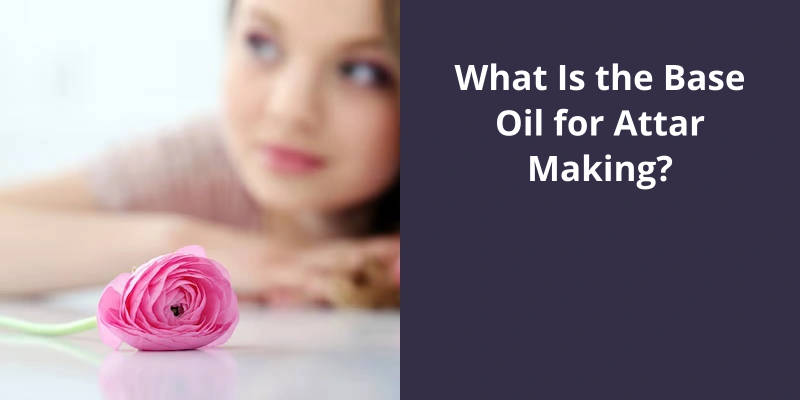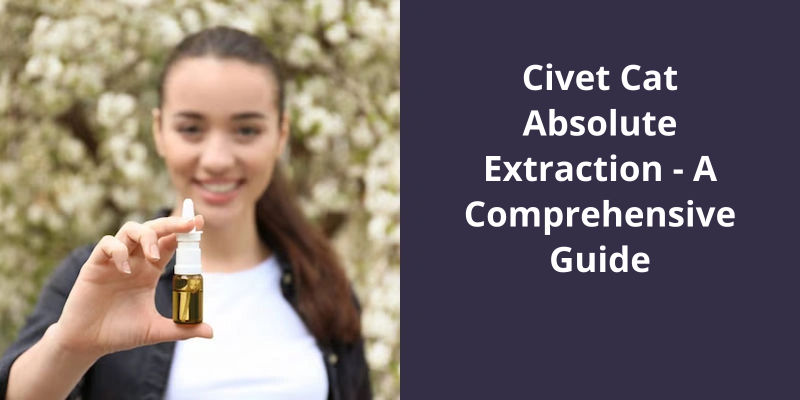The base oil for attar making is typically a neutral, scentless carrier oil that allows the fragrance of the essential oils to stand out. These base oils, also known as fixed oils, are usually vegetable oils like jojoba oil, grapeseed oil, or sweet almond oil. They are required to dilute the potent essential oils, making them safe for skin application while maintaining their aromatic properties. The combination of these base oils with carefully chosen essential oils results in the unique and potent fragrance of attar.

What Is the Process of Making Attar?
Attar, also known as ittar, is a highly sought-after and luxurious perfume oil that’s been cherished for centuries. The process of making attar is a truly intricate and time-consuming art form. True attars are created through a slow and laborious process of hydro- or steam-distilling various aromatic materials such as flower petals, herbs, exotic woods, and resins. These precious ingredients are carefully distilled directly into a base of sandalwood oil, which acts as the carrier or base oil for attar making.
One of the most critical steps in crafting attar is the careful selection of the aromatic materials. Different flowers and herbs are chosen for their unique scents and properties. The petals or plants are harvested at specific times, usually early in the morning when their fragrance is at it’s peak. This ensures the highest quality and potency of the attar.
Once the aromatic materials are chosen, they’re carefully distilled using either the hydro-distillation or steam distillation method. In hydro-distillation, the aromatic material is soaked in water, and heat is applied to encourage the release of essential oils. The steam distillation method involves passing steam through the aromatic material, which causes the essential oils to be released. Both methods require gentle heating and meticulous monitoring to preserve the delicate fragrance and therapeutic properties of the ingredients.
During the distillation process, the essential oils and vapors are captured and condensed. Sandalwood oil is highly prized for it’s own unique scent and properties. It not only enhances the fragrance of the attar but also provides a long-lasting base that helps the scent last for extended periods.
Once the distillation is complete, the attar is carefully aged and matured for several months or even years. This aging process allows the fragrance to develop and deepen, resulting in a more complex and sophisticated scent. The attar is sealed in beautiful handmade glass bottles, symbolizing it’s exquisite nature and craftsmanship.
The selection of high-quality ingredients and the careful craftsmanship ensure the creation of truly exceptional and highly sought-after perfumes. The result is a luxurious and exclusive fragrance that captivates the senses and has been cherished for generations.
The History and Cultural Significance of Attar-Making
Attar-making is an ancient art that dates back several centuries. It’s deep cultural significance, particularly in the Middle East and South Asia. Attar refers to a perfume oil derived from the extracts of various natural ingredients such as flowers, herbs, spices, and wood. The base oil used in attar-making is typically a carrier oil, which serves as a neutral base to dilute and extract the fragrance from the botanical materials.
The choice of base oil is crucial as it should be able to preserve the fragrance and allow it to develop over time. Some commonly used base oils in attar-making include sandalwood oil, jojoba oil, almond oil, and grape seed oil. These oils possess unique characteristics that can enhance and complement the aromatic profile of the attar.
Attar-making is more than just a craft; it’s steeped in tradition and holds significant cultural importance. The process typically involves steam distillation or solvent extraction, where the natural ingredients are carefully processed to obtain their essential oils. The attar is then meticulously blended to create unique and captivating fragrances.
Throughout history, attar has been cherished for it’s captivating scents and believed to have therapeutic properties. It plays a prominent role in various cultural practices, such as traditional medicine, religious ceremonies, and personal adornment. Attars are often named after the main floral or botanical ingredient, adding to their allure and individuality.
Attar-making continues to thrive today, with skilled artisans preserving the traditional techniques while also incorporating modern innovations. The fragrant creations from this ancient art form continue to captivate senses and hold significant value in cultural heritage.
The base oil used in attar, a highly cherished fragrance in India and South Asia, is sandalwood oil. This versatile oil not only possesses a captivating scent but also serves as a practical component in attar production. Through the meticulous steam-distillation of various flowers, fragrant woods, and resins, attar artisans artfully blend these aromatic elements into the rich base of sandalwood oil, creating a captivating olfactory experience.
What Is the Base Oil Used in Attar?
What’s the base oil used in attar? In India and South Asia, an attar is very specific: It’s the result of painstakingly steam-distilling flowers, fragrant woods, and resins into a base of sandalwood oil. Sandalwood, it turns out, has a practical use beyond it’s intoxicating aroma.
Sandalwood oil is highly regarded for it’s therapeutic properties and often used in traditional Ayurvedic medicine. It’s a soothing and calming effect, making it an ideal base for attar, which is known for it’s aromatic and therapeutic benefits. The oil acts as a carrier, facilitating the absorption and longevity of the fragrance.
This makes attar not only a delight for the senses but also a potential remedy for various skin conditions and mood imbalances.
This choice is a combination of tradition, therapeutic properties, and scientific compatibility. It’s unique characteristics allow it to effectively bind with aromatic compounds, act as a fixative, and offer additional therapeutic benefits.
The Process of Steam-Distilling Flowers, Fragrant Woods, and Resins to Make Attar
- Steam-distillation process to make attar:
- Collect flowers, fragrant woods, and resins
- Place the botanical materials in a distillation apparatus
- Heat water in a separate container to produce steam
- Direct the steam into the distillation vessel containing the botanicals
- The steam carries the volatile oils from the plants
- As the steam cools, it condenses into a liquid
- This liquid is collected in a separate container
- The collected liquid is known as attar or essential oil
- Repeat the process with fresh botanical materials for a stronger attar
- Filter and store the attar in a dark glass bottle to preserve it’s fragrance
- Attar is used in perfumes, aromatherapy, and traditional medicines
When it comes to attar, a type of perfume oil, the carrier oil used is essential for providing an extended and balanced fragrance. Pure attars can be enhanced and diluted using carrier oils such as jojoba or fractionated coconut oils. These oils not only help maintain the integrity of the attar but also make it easier to create perfumes or add fragrance to skin care products.
Which Carrier Oil Is Used in Attar?
When it comes to attar making, the choice of carrier oil is essential in ensuring the purity and effectiveness of the final product. One of the most commonly used carrier oils in attar making is jojoba oil. This unique oil is extracted from the seeds of the jojoba plant, and it’s chemical composition closely resembles sebum, the natural oil produced by our skin. Jojoba oil is non-comedogenic, meaning it doesn’t clog pores, making it an excellent choice for attar formulations. It’s lightweight texture allows for easy absorption into the skin, leaving it moisturized and nourished.
Unlike regular coconut oil, which solidifies at lower temperatures, fractionated coconut oil remains in it’s liquid form. This makes it easier to work with and blend with other essential oils. Fractionated coconut oil is highly stable and has a long shelf life, making it ideal for attar formulations. It also has a light, non-greasy texture that allows it to be easily absorbed into the skin, leaving it soft and smooth.
These diluted blends not only help to enhance the aroma of the attar, but they also make it easier to use in a variety of applications. For instance, the diluted attars can be used to create perfumes, where they can be applied directly to the skin or added to an alcohol base. They can also be used to fragrance skin care products such as body lotions, creams, and oils, adding a luxurious and exotic touch.
Jojoba oil and fractionated coconut oil are both excellent choices due to their compatibility with essential oils, their skin-nourishing properties, and their ability to enhance the aroma of pure attars. So go ahead and explore the art of creating your own unique and captivating fragrances with these wonderful base oils.
Source: Attars FNWL – From Nature With Love
Now that we’ve discussed the process of making attar from essential oil, it’s important to explore it’s potential benefits and uses. Attar, derived from a combination of essential oil and benzyl benzoate, is a highly concentrated fragrance oil that can be used in various applications. From personal care products to aromatherapy, attar offers a unique and captivating scent that lingers for long-lasting enjoyment. In the next section, we will delve deeper into the diverse range of attar fragrances and how they can enhance your daily life.
Can We Make Attar From Essential Oil?
One popular misconception about attar making is that it can be done solely with essential oils. The base oil is an essential component that determines the quality and longevity of the attar.
The answer lies in the combination of essential oils and benzyl benzoate. This combination not only enhances the fragrance but also serves as the base oil for the attar. The combination should be thorough and well-blended to ensure the desired fragrance is achieved.
Once the mixture is ready, it can be added to an empty glass attar bottle. The bottle should be clean and free from any traces of previous scents or contaminants. Pouring the mixture into the bottle requires precision and care to avoid spillage and wastage.
However, patience is paramount in the attar making process. After filling the bottle with the essential oil and benzyl benzoate mixture, it’s essential to wait for approximately 24 to 48 hours before using the attar. This waiting period allows the ingredients to settle and merge, creating a harmonious and balanced fragrance.
During this waiting time, it’s crucial to store the attar bottle in a cool, dark place away from direct sunlight or excessive heat. Exposure to these elements can alter the fragrance and reduce the longevity of the attar. Therefore, it’s advisable to keep the bottle in a safe and suitable location for the desired results.
By following the right process and allowing the ingredients to merge naturally, you can create a mesmerizing attar that will enchant all who encounter it’s fragrance.
The Potential Effects of Exposure to Sunlight and Heat on the Fragrance and Longevity of the Attar.
- Increased exposure to sunlight can cause the fragrance of attar to weaken over time.
- Prolonged exposure to heat may also lead to changes in the scent profile of the attar.
- The ultraviolet (UV) rays in sunlight can break down the chemical compounds in attar, affecting it’s longevity.
- It’s advisable to store attar in a cool, dark place to mitigate the potential effects of sunlight and heat.
- Note that individual variations in fragrance sensitivity and the composition of each attar may also influence it’s reaction to sunlight and heat.
Both attar and attar oil are widely used in perfumery, but they differ in their composition and production process. While attars can contain additional natural ingredients like herbs and spices, attar oil is purely an absolute extract of a single ingredient derived from plants. This distinction plays a significant role in the unique scents and applications of these fragrances.
What Is the Difference Between Attar and Attar Oil?
Attar, also known as ittar or ittr, is a type of fragrance derived from natural sources such as flowers, herbs, spices, and other botanical materials. It’s a long history and is deeply rooted in the traditions of the Middle East, India, and other parts of the world. Attar making is an art that involves the distillation of these natural ingredients to extract their aromatic essence.
The base oil used in attar making plays a crucial role in the final fragrance composition. It serves as the carrier for the aromatic compounds and helps to dilute and preserve the concentrated attar. Various base oils can be used, such as sandalwood oil, jojoba oil, coconut oil, and grape seed oil.
Coconut oil and grape seed oil are also popular choices for base oils in attar making. Coconut oil is rich in fatty acids, providing a smooth and moisturizing effect on the skin. It’s a pleasant aroma that can complement the natural scents of attars. Grape seed oil, on the other hand, is a lightweight and non-greasy oil that absorbs quickly.
Different Techniques and Methods of Attar Making
Attar, also known as ittar or essential oil, is a fragrant oil extracted from various natural sources such as flowers, herbs, spices, and wood. It’s been used for centuries in the production of perfumes, oils, and traditional medicines.
There are several techniques and methods used in the making of attar. One common method is steam distillation, where plant materials are heated with water to extract the essential oils. The steam evaporates, carrying the fragrant molecules with it, and then condenses to form the attar.
Another technique is called enfleurage, which involves placing fresh flowers or petals in a layer of fat. Over time, the fat absorbs the fragrance of the flowers, and the process is repeated several times until the fat is saturated with the desired scent. The fat is then washed with alcohol to separate the attar from the fat.
Some attars are also produced using the solvent extraction method. In this process, plant materials are mixed with a solvent like hexane or ethanol to dissolve the essential oils. The solvent is then evaporated, leaving behind the concentrated attar.
The choice of base oil for attar making depends on the desired scent, consistency, and blending characteristics. Common base oils used include sandalwood oil, jojoba oil, coconut oil, almond oil, and grape seed oil. These base oils act as carriers for the aromatic molecules, enhancing their longevity and ease of use.
Overall, attar making is a delicate and intricate process that requires skill, knowledge, and patience to capture the true essence of the natural ingredients used.
Conclusion
This aromatic oil serves as a medium for the hydro-distillation of various natural ingredients such as flower petals, spices, and wood, allowing their scent to be captured and infused into the final product. Through this traditional method of attar making, the essence of nature is transformed into a captivating olfactory experience, providing individuals with a touch of nature's beauty in the form of a perfume.





